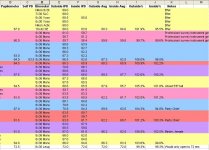Kammerdiner
Well-known member
Recently there was some debate (I forget which post) about the size of the FL sweet spot, especially the 8x32. I've had my 8x32 for about a month now and am willing to say that the "super-sweet" spot is in fact fairly small, but that it is surrounded by a large "semi-sweet" donut, an area just a tiny bit less sharp.
As a result, I find that IPD on the Zeiss is more critical than on my other 8x32's. I was having fits trying to get both barrels super-sweet and then realized I generally had the IPD set a bit too wide. Narrowing it lined up the super-sweet spots and now these things rock. I notice that, like porros, it helps to narrow the IPD for closer distances--something that most roofs don't need except at minimum distances.
Any of this sound familiar? I'm curious about how others see this. If the FL's weren't so doggone sharp I doubt I'd ever have picked up on it.
Mark
As a result, I find that IPD on the Zeiss is more critical than on my other 8x32's. I was having fits trying to get both barrels super-sweet and then realized I generally had the IPD set a bit too wide. Narrowing it lined up the super-sweet spots and now these things rock. I notice that, like porros, it helps to narrow the IPD for closer distances--something that most roofs don't need except at minimum distances.
Any of this sound familiar? I'm curious about how others see this. If the FL's weren't so doggone sharp I doubt I'd ever have picked up on it.
Mark






